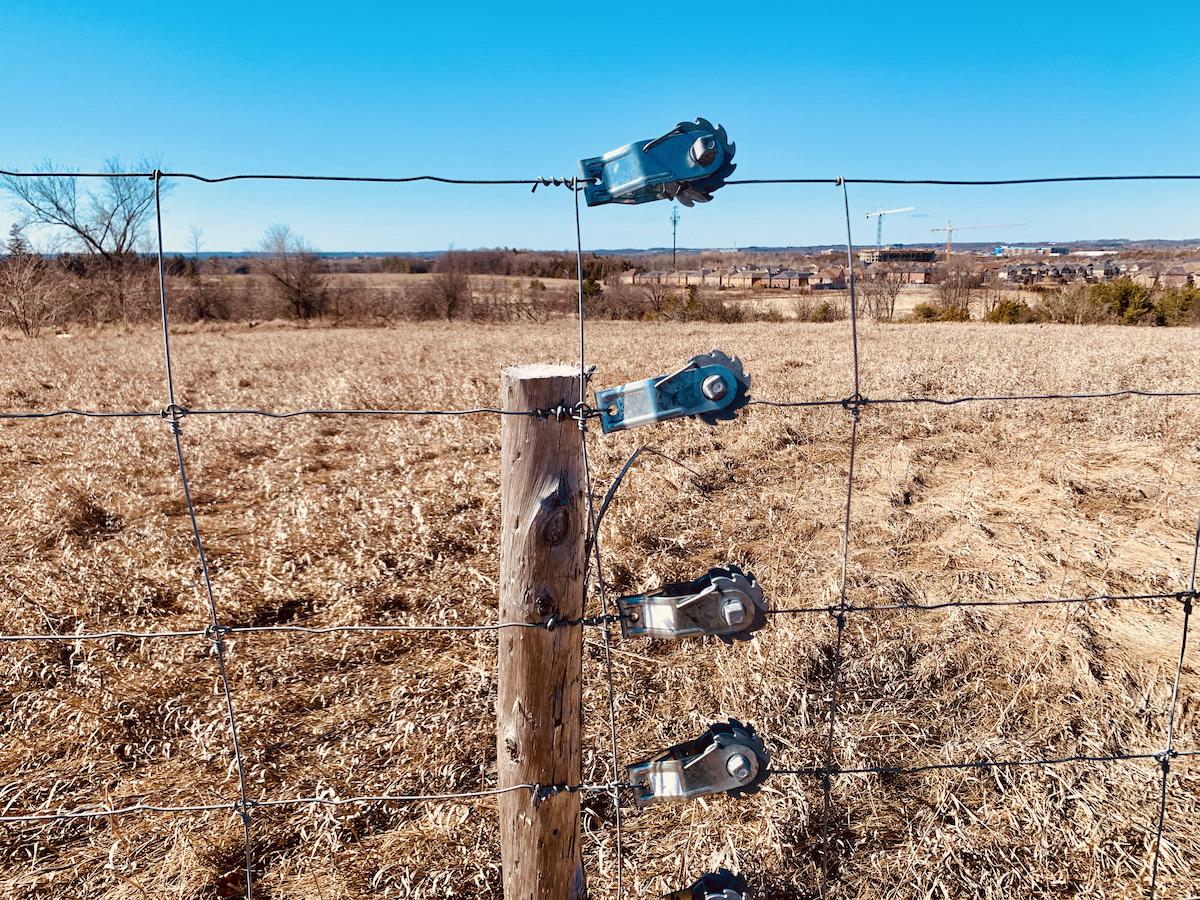
A sign along Harvest Trail in Rouge National Urban Park asks hikers to share the path with farm equipment/Jennifer Bain
The drive to the start of the Harvest Trail meanders down a rural road past market gardens selling brown eggs and honey, alongside fields waiting to be planted with wheat, soy and corn crops, and past glorious old barns and yellow warning signs ordering motorists to share the road with tractors.
Canada’s national parks typically protect natural and cultural heritage, but Rouge National Urban Park is unique. It’s the country’s only national urban park and two-thirds of it protects agricultural heritage. This Class 1 farmland is “the rarest, richest and most fertile in the country,” according to Parks Canada, and the park is still home to working farms.
Parking at the 19th Avenue Day Use Area, I spot a sea of subdivisions to the north of the trailhead and know that downtown Toronto looms to the south. It hits home that Rouge, which turns six in May and can be reached by public transit, is within a one-hour drive of 20 per cent of Canada’s population.
I had to drive Rouge top to bottom to wrap my head around its jagged, sprawling boundaries. At nearly 80 square kilometres (31 square miles), Rouge is reportedly 19 times bigger than New York’s Central Park and 16 times larger than Vancouver’s Stanley Park.

The Harvest Trail is wide and flat and meanders between fenced farm fields/Jennifer Bain
The park-in-progress spans the Greater Toronto Area from Uxbridge to Markham and Scarborough, linking the Oak Ridges Moraine to Lake Ontario. It’s only 95 per cent complete and more land transfers are expected. With hundreds of access and entry points, it’s also impossible to tally annual visitors, but Rouge staff set half a million as a baseline. That was before Covid-19 and the travel restrictions that forced people to embrace local green spaces, so numbers are going up. Apparently, so is the illegal dumping of household waste and construction materials.
Before this early spring hike, I read Rouge’s 2019 management plan, all 88 pages of it.
This is a “learn-to” park that aims to bring a diverse urban population, especially new Canadians and young people, “in contact with nature, culture and agriculture.” Because it’s a new category of protected area, Rouge didn’t fit into the Canada National Parks Act and so the Rouge National Urban Park Act was created. The top priority is maintaining or restoring ecological integrity. Providing greater certainty for farmers and promoting a vibrant farming community are other priorities.
Rouge has more than a dozen marked trails, but staff say Harvest Trail showcases the agricultural land that I’m most curious about. Actually, it’s currently called “Trail” but it’s getting renamed Harvest Trail in May to reflect the area’s farming history. It’s described as an easy, family-friendly, linear trail that weaves through crops, marshland and shaded woodlot for 90 minutes to two hours. The trail ends at the Reesor Road Day Use Area, and so I’ll have to double back to my car.

A "no dumping" sign in Rouge National Urban Park/Jennifer Bain
Before setting off on the 4.3-kilometre (2.7-mile) southbound trail, I read up on the Rouge Valley’s vibrant farming community and take in four warnings. The bathroom — a modern outhouse — has a Covid alert that says it’s cleaned daily but that we’re responsible for our own safety. We still need to physically distance outside, a black bear has been spotted in the area and this area is a hotspot for ticks.
We love our warning signs in Canada.
A family asks for directions and I cheerfully say it’s my first time here, too. It feels strange to talk to strangers again, but soon I’m saying “hey there” and “hi” and nodding and smiling as I pass people and their kids and pets out for a stroll along wide, flat paths through the promised farmland on a warm March day.
“Stay on marked trails,” a Rouge sign urges. “Access to agricultural lands is not permitted.” The fields are fenced but nobody’s out working and there aren’t any crops to admire yet.

Fence strainers (aka wire tigheners) show up on some of the park fences by farmland/Jennifer Bain
Parks Canada reminds us that Indigenous peoples used this area for thousands of years before settlers started farming in the Rouge Valley in 1799. Many early farmers were pacifist Pennsylvanian Mennonites who arrived after the American Revolutionary War to get cheap land and military service exemptions.
Mennonite scouts sought black walnut trees that signalled fertile soils. One scout, Peter Reesor (immortalized with Reesor Road), arrived in the late 1790s and soon built one of the first grist and saw mills on the Rouge River. Mennonite migration peaked between 1803 and 1807 as other groups from the United States (Germans, Quakers, Scots, English and Dutch settlers) arrived. This immigration slowed after the War of 1812, but new “re-settlers” arrived from England and Ireland in the 1820s and 1830s.
I glean all this history from Rouge’s website and expect it will one day be on interpretive displays throughout the park. I also read how early pioneers lived in log cabins and used “sturdy tools and oxen” to clear the land for pasture or to grow oats, rye, buckwheat, potatoes, turnips and corn. When tree stumps left from clearing the land rotted enough to allow ploughing and harrowing, wheat could finally be planted.
Parks Canada says farmers eventually upgraded to brick and stone homes, adopted new fertilization techniques, grew new crops and bred new animals. There were apple orchards along with oats, peas, potatoes, hay, butter, pork, wool, eggs and poultry. There were gendered roles, with men doing field, livestock and business work, and women caring for kitchen gardens, chickens and dairy cows, and selling extra produce at local markets.

A sign says to share the road with tractors as a farm and barn loom in the background/Jennifer Bain
By the 1890s, the rural population started to drop as people left for urban areas, agriculture was mechanized and the soil was exhausted. By the mid-1900s, after the Great Depression and Second World War, the Rouge Valley started becoming engulfed by suburbs.
Parks Canada says this shift was spurred by the opening of the Yonge Street subway in 1954, the advent of subdivisions in the 1970s and the creation of highways. That’s why it became so important to create Rouge and protect the area’s dwindling farmland, dairy farms, market gardens and locally grown corn, soy and wheat crops.
On one elevated part of the Harvest Trail, the skies are clear enough to see downtown Toronto’s skyscrapers. I make pitstops at a scenic lookout, cross multiple short boardwalks (one with a pergola) and rest in seating areas made from rocks and a split tree trunk.
The crows and hawks are out, and I stop to admire tree swallow boxes and three tin cans attached to Hawthorn trees. Parks staff later guess they’re homemade bird feeders. They also tell me that white plastic wraps around the base of young trees are guards to prevent rabbits and deer from eating precious bark.

Mullein is a hairy, invasive, mostly unloved plant/Jennifer Bain
There are occasional cattails and old corn cobs stripped of their juicy kernels lying on the ground, plus young white spruce likely planted during restoration projects. There are rosettes of fuzzy leaves that will soon grow into unloved and invasive hairy mullein plants with clusters of small, yellow flowers.
The most exciting moment on this peaceful hike is when the wire fence suddenly ends in one small section with a warning sign that says: “Farm crossing. Yield to farm equipment.” There’s no machinery out today, though, and the trail doesn’t pass by any of the old barns I spotted while driving.

A vintage abandoned car, hidden in the bush by the trail/Jennifer Bain
The Rouge is proudly home to two main types of barns. Large, two-storey Central Ontario or bank barns have lower-level stables and upper levels for crop storage or work space. Smaller, one-storey English or three-bay barn have distinct areas for a stable, storage and threshing floor.
When I cross Elgin Mills Road, I forget this is the end of the Harvest Trail and that the Reesor Road Day Use Area parking lot is just a short walk to the east. Instead, I keep heading south on a new 1.25-kilometre (0.7-mile) stretch called West Trail, past green “silt socks” filled with wood chips and leaf debris that prevent erosion and sedimentation during construction around water bodies.

A hand-painted rock says "Protect the Earth" is left on the trail for a stranger to find/Jennifer Bain
It’s on way way back north on West Trail that I spot an abandoned vintage car, its windows long gone, its roof covered in dried grass, the remnant of a past farmer. I don’t dare step off the trail for a closer look and I know that in a few short weeks the spring foliage will once again hide this relic. I do excitedly point it out to a couple walking by.
Two hours and 20 minutes after I began this stroll, I’m back where I started near the parking lot. This time I notice a short stretch of trail that heads north to the closest subdivision. I follow it down a hill, through a small forest and to the end, where I spot one of those kindness rocks that kids paint with messages and leave for others to discover. Ethan C. created this one.
His message? “Protect the Earth.”

 Support Essential Coverage of Essential Places
Support Essential Coverage of Essential Places




Comments
Great article. Cuyahoga National Park allows farming as well. I'd rather see farms than houses everywhere.
Rightwingers have been threatening the conservation and preservation communities with that accept farming and ranching or lose it all line for decades. It's a variation of a "struggling will only make it worse" threat. It's old; it's offensive; and it's immoral.
There are working farms on NPS land in Marin County.
Point Reyes National Seashore obviously is the most prominent because of the working dairy and beef cattle ranches. Bolinas Ridge has cattle grazing and is technically part of Golden Gate National Recreation Area, but administered by the staff at Point Reyes. There's also Slide Ranch in the Marin Headlands. The latter has an education mission, but they run a small working farm on the land as part of that mission.
John Muir National Historic Site still keeps a limited orchard and allows visitors to pick fruit. Also there's the apples at Curry Village in Yosemite which were planted over a century ago. There are problems with bears searching for fruit and talk about perhaps removing the trees. There's an annual apple harvest to try and keep down the apples that might be around for bears and other wildlife.
Oh, yes indeed, a lot of cheese coming from Point Reyes.